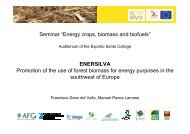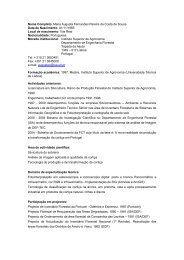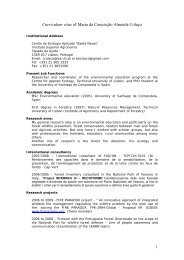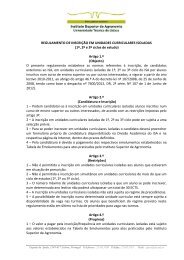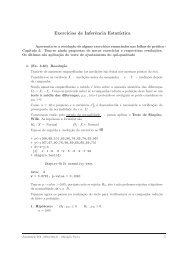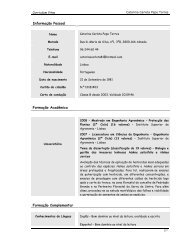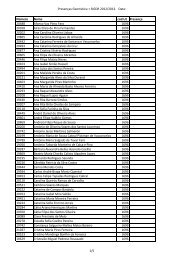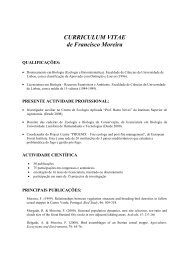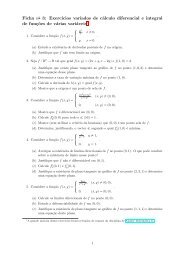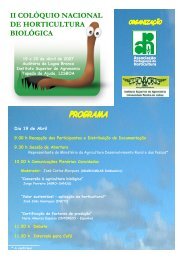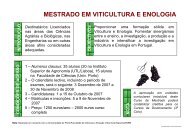X-ray Absorption Spectroscopy Reveals a Substantial Increase of ...
X-ray Absorption Spectroscopy Reveals a Substantial Increase of ...
X-ray Absorption Spectroscopy Reveals a Substantial Increase of ...
Create successful ePaper yourself
Turn your PDF publications into a flip-book with our unique Google optimized e-Paper software.
11656Sulfur Oxidation in TTR upon FibrillizationTABLE ISpacing <strong>of</strong> equatorial and meridional reflectionsMeridional Equatorial Relative intensityd(obs) Åd(obs) Å12.5 s10.3 w6.56 m4.85 m4.65 s4.15 wmeasurements <strong>of</strong> spin-labeled TTR mutants suggest a distance<strong>of</strong> 8 Å between subunits interfaces in the fibrils (15) thatcould originate that reflection.The three observed meridional reflections indexed as Braggreflections, fit a repeating unit <strong>of</strong> 116.3 Å 0.1, close to the115.5 Å already proposed (7). This 4 higher period (4 29 116 Å), can be due to a twist in the -strands along the fibrilaxis, leading to the 116 Å repeat.Sulfur K-edge XANES—The K-edge spectra <strong>of</strong> cysteine, cystine,methionine, methionine sulfoxide, and anthraquinone-2-sulfonic acid are shown in Fig. 2. The energies <strong>of</strong> maximumabsorption for these compounds are 2.4730, 2.4723, 2.4731,2.4759, and 2.4809 keV, respectively. The scans were run witha step size <strong>of</strong> 0.00017 keV near the edge region, and the measuredvalues are in agreement with those found in the literature(11, 16). The shapes <strong>of</strong> the spectra are clearly different exceptfor cysteine and methionine that look very similar. Moreover,as described in previous studies (16), it can be observed that thehigher the energy <strong>of</strong> maximum absorption the greater is thepeak area.The sulfur K-edge spectra <strong>of</strong> the WT-, V30M-, L55P-, andC10S-TTR samples are shown in Fig. 3. Some conclusions ariseimmediately from the observation <strong>of</strong> the spectra. There are noS–S bonds present in the samples as neither spectra shows thecystine characteristic peak. The three energies <strong>of</strong> maximumabsorption observed are 2.473 keV, 2.476 keV, and 2.481 keVindicating the presence <strong>of</strong> cysteine and/or methionine, methioninesulfoxide, and sulfonated cysteine. Although the shapes <strong>of</strong>the spectrum <strong>of</strong> TTR variants are roughly similar, there arepronounced differences between the non-polymerized and thepolymerized forms: in the fibrillar samples there is a largeamount <strong>of</strong> oxidized sulfur (stronger peak at 2.4759 keV fromthe S-sulfoxide and stronger peak at 2.4809 keV from theS-sulfonated).Since more detailed interpretations demand a quantitativeanalysis, the experimental protein spectra were simulated bylinear combination <strong>of</strong> the spectra from the reference samples.The simulated spectra are shown in Fig. 4, and the results <strong>of</strong>the fits and corresponding relative errors are presented inTable II.TTR is a homotetramer with 127 amino acids per monomer.Cys-10 and Met-13 are the only sulfur-containing amino acidsin the wild-type protein and L55P-TTR. V30M-TTR containsone cysteine and two methionines and variant C10S-TTR containsonly one methionine.In the non-polymerized protein samples there is a higherfraction <strong>of</strong> cysteines oxidized to the sulfonated form (24–28%)then methionines oxidized to the sulfoxide form (10% or less),which is consistent with Cys-10 being more exposed to thesolvent then Met-13 as revealed by the x-<strong>ray</strong> crystallographicstructures <strong>of</strong> these variants (9, 17, 18). According to the crystalstructure <strong>of</strong> V30M-TTR variant, the extra methionine, Met-30,is buried in the molecule and not exposed to the solvent. Thereforein this case, the methionine sulfoxide probably results onlyfrom the partial oxidation <strong>of</strong> Met-13 as it will be the case for thewild type and the other variant proteins. The presence <strong>of</strong> theFIG. 2. Sulfur K-edge XANES spectra for the referencecompounds.FIG. 3.Sulfur K-edge XANES spectra <strong>of</strong> protein solutions (a)and fibril solutions (V30M-, WT-, and L55P-TTR) (b). V30M-TTRspectra are present in blue, WT-TTR in black, L55P-TTR in redand C10S-TTR in green.S-sulfonated in C10S-TTR variant is residual (2%) and mostimprobable since no cysteines are present in the protein. Thecorresponding peak, which is very small, should arise from themultiple scattering effects at the high energy end <strong>of</strong> the spectra(11).Downloaded from www.jbc.org by on August 30, 2006



